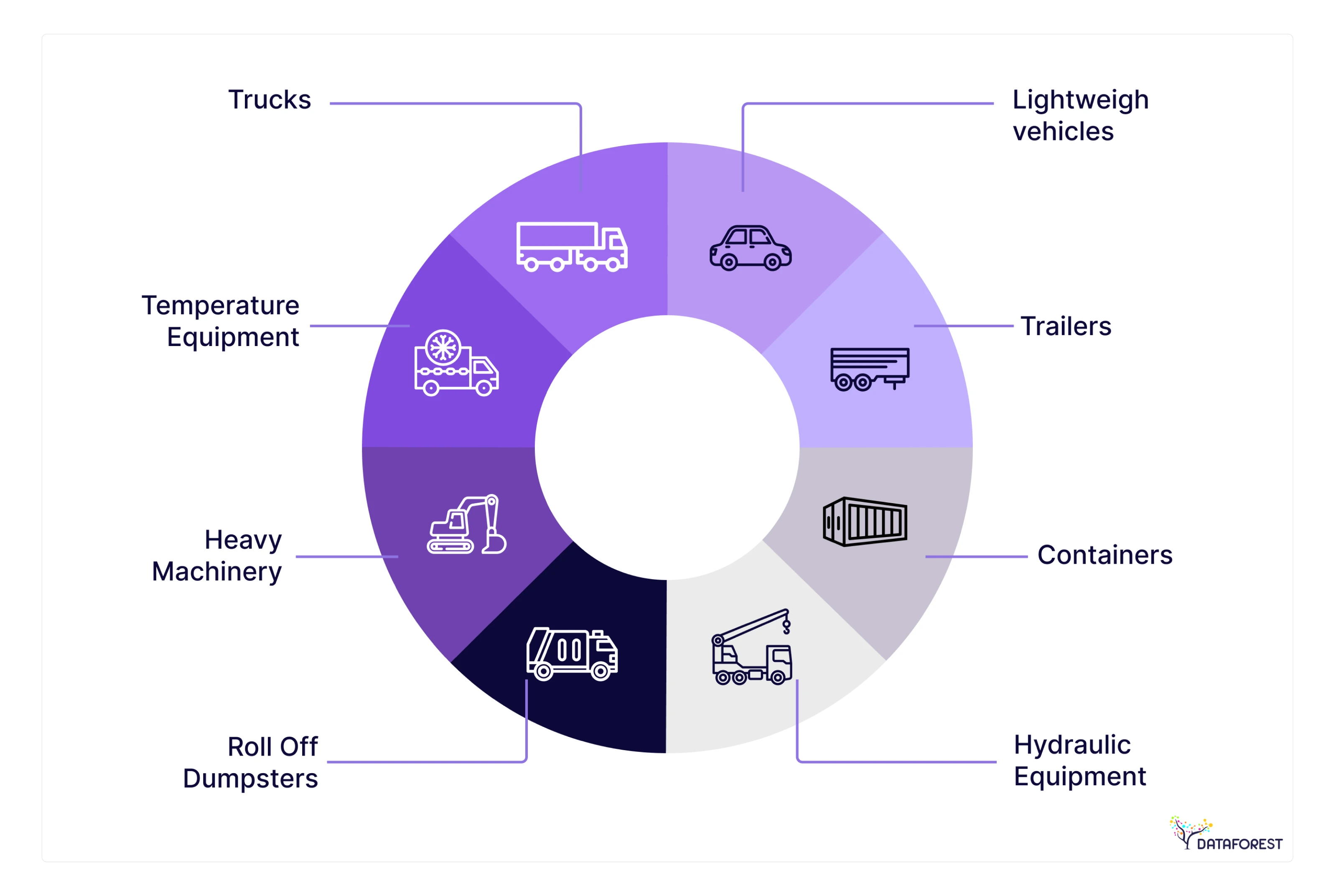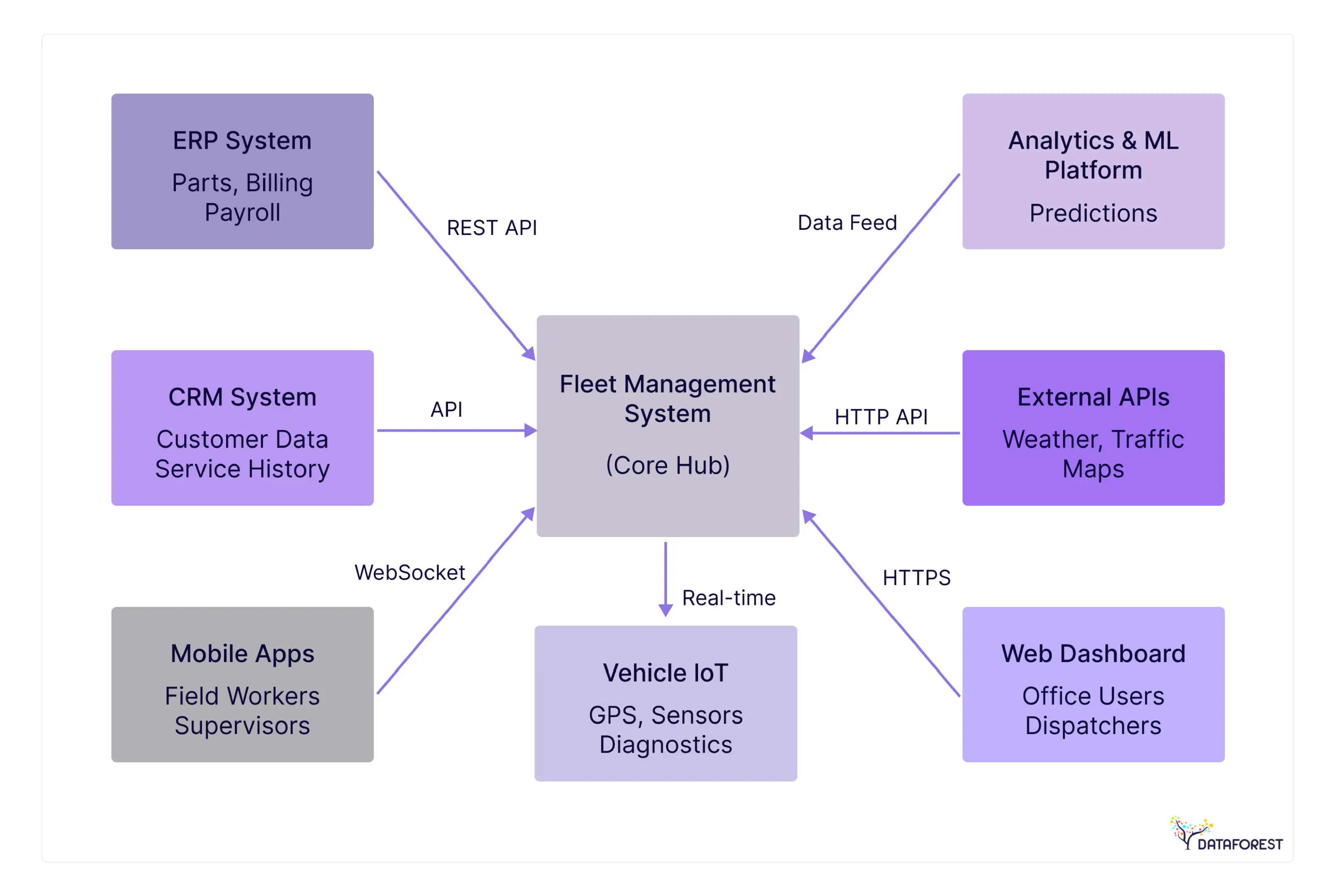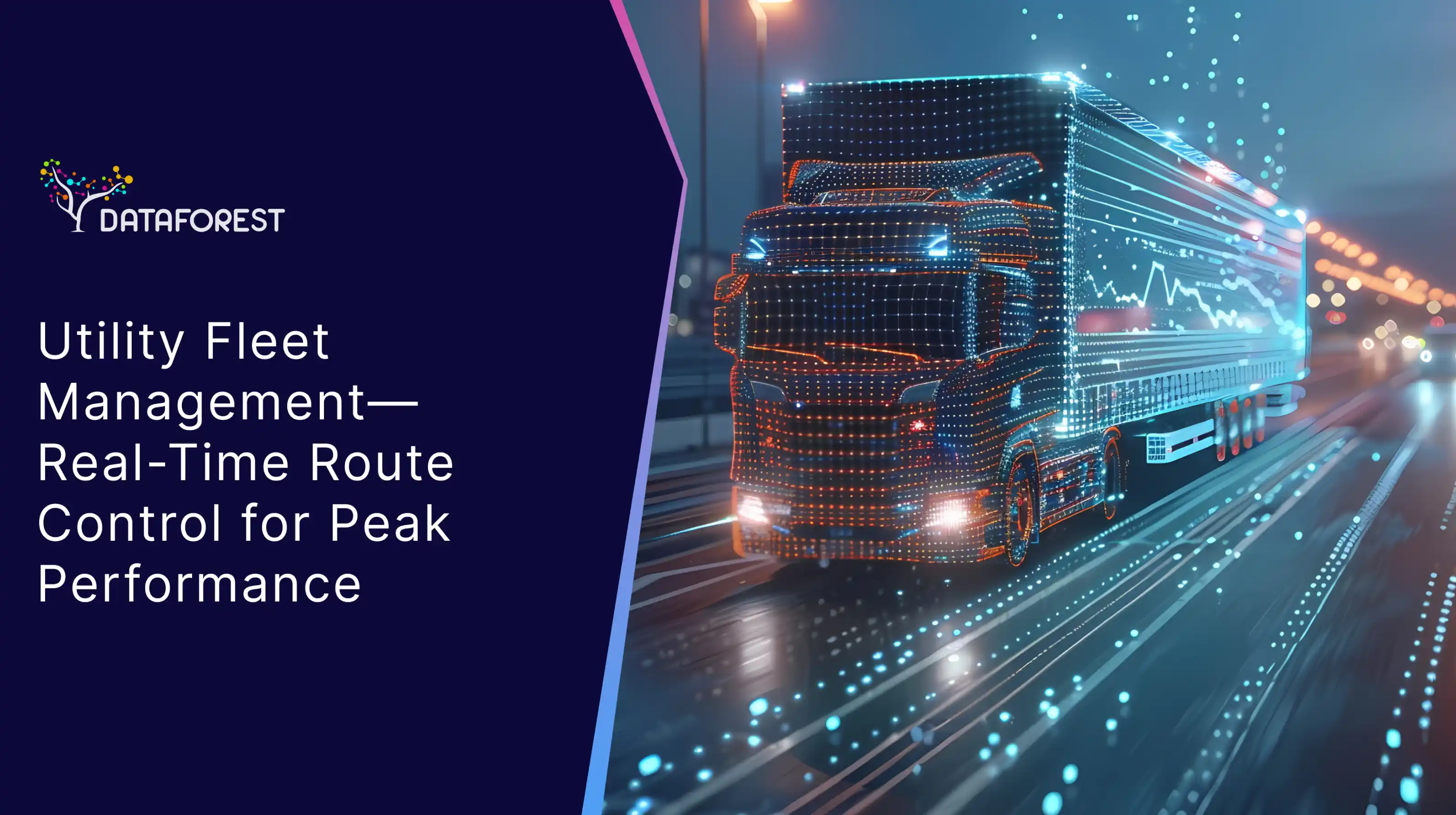One public utility saved $7.5 million by selling unneeded vehicles after implementing fleet management software for utility companies. Utilities have been able to right-size their fleets and reduce motor pool size by up to 30% using this system. A fleet management client achieved a 28% boost in fleet productivity through better data visibility and decision-making with an integrated fleet analytics dashboard. The software showed them exactly where their vehicles were wasting time and resources. For the same purpose, you can book a call with us.

Why Do Utility Companies Need Responsive Fleet Management Apps?
McKinsey is sure that connectivity and advanced analytics are transforming fleet management solutions for utility companies—from real-time route planning to proactive maintenance. Fleet managers can't run operations from their phones with old systems. Responsive enterprise applications let them track trucks, assign jobs, and handle emergencies from anywhere with internet access.
Current Problems with Old Fleet Systems
Most fleet management systems for utility companies still use desktop software that is only compatible with office environments. Field supervisors can't see where trucks are when they're driving between job sites. Dispatchers waste time calling drivers to find out their locations and availability. When storms strike, managers must coordinate hundreds of vehicles from multiple locations. Old systems force them to drive back to headquarters to see the big picture. This delay costs money and frustrates customers waiting for power restoration.
Digital Technology Changes Everything
Cloud-based utility fleet management software has become standard over the last five years. Companies moved from paper logs and radio calls to fleet tracking systems with real-time GPS tracking. Progressive web apps have replaced clipboards, giving field workers direct access to job schedules. The shift occurred because internet coverage improved and smartphones became more affordable. Now, every utility worker carries a computer in their pocket. Companies that ignore this change will fall behind competitors who can respond more quickly to service calls.
How Responsive Apps Help Field and Office Teams
- Field crews receive job assignments directly on their phones, eliminating the need for a dispatch call. They can update job status, order parts, and request backup from their vehicles. Photos of equipment problems are automatically uploaded to the central utility's web-based logistics platform.
- Office managers view all vehicles on a single map screen. They can reassign jobs when emergencies happen or traffic blocks routes. Real-time data enables them to make decisions without guessing the location of trucks.
- The same fleet management software used by utility companies provides cross-platform compatibility with tablets, phones, and computers. This means supervisors can manage automated fleet operations from home during off-hours. Response times drop because nobody has to wait for someone to get back to the office.
What Does Fleet Management Software Need to Work?
Most fleet management solutions for utility companies fail because they can't handle real-time data from actual trucks.
Getting Data from Trucks and Equipment
Every vehicle needs sensors that report location, engine status, battery health, and fuel levels. The GPS telematics unit communicates with satellites every few seconds to track the geolocation of trucks. Vehicle diagnostics catch problems before they strand drivers on highways.
Cloud Storage That Won't Break
Your data lives on someone else's servers because your office can't handle thousands of GPS pings per hour. Cloud platforms, such as AWS or Microsoft Azure, process this flood of information without crashing. They cost money, but they don't fail when you need them most. This robust infrastructure ensures data compliance with utility regulations and cybersecurity standards.
Making Data Visible on Screens
WebSocket technology pushes updates to your screen without requiring a page refresh. Progressive Web Apps work offline when the internet connection is unavailable in remote areas. Real-time maps show truck locations as they move, not where they were five minutes ago.
Keeping Hackers Out
Utility fleet management software includes customer addresses, equipment locations, and worker schedules. Access control means that only dispatchers see the dispatch screens and only mechanics see the maintenance data. Encryption protects information as it travels between trucks and your office.
How Do You Build Apps That Work for Both Truck Drivers and Office Staff?
Field workers need simple buttons they can tap with gloves on, while dispatchers need complex dashboards with lots of data.
- Why mobile screens come first. Field crews use phones and tablets in moving trucks on bumpy roads. If your fleet management in utility companies works on a small screen with thick fingers, it will work everywhere. Office workers can handle complex interfaces, but drivers require large buttons and straightforward choices.
- Making route changes fast and simple. Dispatchers need to drag jobs between trucks on a map without having to open ten different screens. Field workers need to mark jobs as complete with a maximum of two taps. Good design means people can do their jobs without having to think about the software.
- Working when cell towers die. Rural areas often have dead zones where the internet is unavailable for miles. Your utility fleet management app must cache job details, maps, and customer info on the device. When the signal returns, the app uploads completed work and downloads new assignments without losing anything.
Select what you need and schedule a call.
How Do Smart Routes Save Utility Companies Money Every Day?
Bad routes waste thousands of gallons of fuel while customers wait hours for service calls that should take minutes to reach.
How Math Finds the Best Routes
Utility fleet management software uses algorithms that calculate millions of possible combinations to find the shortest path. The software considers job priority, truck capacity, distance, and worker skills when building daily schedules. What used to take dispatchers hours of planning now happens in seconds, yielding better results through traffic pattern analysis and multi-stop route planning.
Real-World Problems That Ruin Perfect Routes
- Traffic jams can add two hours to a 30-minute drive, so the system checks live traffic data before sending trucks.
- Weather conditions affect which roads bucket trucks can safely use during storms.
- Some vehicles can't cross low bridges or navigate narrow streets, forcing the software to find alternate paths.
Money Saved Through Better Planning
Companies typically cut fuel costs by 15-20% when they stop sending trucks on wasteful routes. Service calls get completed faster because crews spend more time working and less time driving. Emergency response improves because the logistics and fleet management solutions for utility companies automatically select the closest available truck, rather than the first responder to answer the radio.
How Do You Connect Fleet Software to Everything Else Your Company Uses?
Fleet lifecycle management solutions don’t exist in isolation; they require customer data, billing systems, and maintenance records. Companies waste money when these systems can't talk to each other, and workers enter the same information multiple times.
Connecting to Business Systems You Already Have
Your ERP system handles parts inventory, payroll, and financial reporting that fleet managers need daily. Customer service representatives use CRM systems to track service requests and billing information. Utility fleet management software must retrieve customer addresses from the CRM and transmit completed work orders back to the ERP for delivery billing.
Without integration, dispatchers must manually copy customer information between systems, which can result in errors. Mechanics can't see if replacement parts are in stock because fleet management software for utility companies doesn't connect to inventory systems. Billing departments wait for paper reports instead of receiving automatic updates when jobs are completed.
Making Different Software Systems Talk Together
APIs are like translators that let different software programs share information automatically. Modern fleet management solutions for utility companies use REST APIs and JSON data formats that most business software can understand. Integration platforms like Zapier or MuleSoft connect systems that weren't designed to work together.
The challenge is that every company uses different combinations of software from different vendors. Some systems have good APIs while others only export data to Excel files. IT departments spend months building custom connections between systems that should work together automatically.
Using Smart Software to Predict Problems
- Machine learning analyzes years of maintenance records to predict when vehicles will need repairs.
- The utility fleet management system learns which drivers are harder on equipment and which routes cause more breakdowns.
- Analytics can spot patterns that humans miss, such as particular trucks failing more often in hot weather.
- Predictive maintenance prevents expensive roadside breakdowns by scheduling repairs before parts fail. Route optimization and vehicle utilization reports become more accurate over time as the system learns traffic patterns and job completion times.
- Automation in scheduling reduces dispatcher workload by handling routine job assignments without human input.

How Do You Prove Fleet Management Software Actually Works?
Innovative companies track specific numbers before and after implementation to show executives exactly how much money the fleet management software for utility companies saves.
Dispatchers handle 40% more service calls per day because they can view all trucks on one screen, eliminating the need for phone calls. Field workers complete more jobs because they spend less time driving between locations and filling out paperwork.
Route optimization reduces fuel costs by 15-20% while predictive maintenance prevents expensive breakdowns that cost thousands in emergency repairs. Companies typically cut their total fleet operating costs by 10-25% within the first year.
Response times drop from hours to minutes because dispatchers automatically send the closest available truck to each emergency. Customer satisfaction scores improve because people get accurate arrival times instead of vague promises.
What Will Fleet Management Look Like in Five Years?
Fleet management solutions for utility companies will make most dispatch decisions automatically while trucks diagnose their own problems and order replacement parts.
Artificial intelligence analyzes traffic patterns, weather forecasts, and job priorities to reassign routes in real-time, eliminating the need for human input. The system learns from thousands of completed jobs to predict how long each task will take and which crew has the right skills. Emergency dispatching occurs in seconds as AI automatically sends the closest truck to respond to power outages or gas leaks.
Smart sensors will monitor tire pressure, brake wear, and engine performance to schedule maintenance before breakdowns happen. IoT devices will track fuel consumption, driver behavior, and cargo weight to optimize every aspect of vehicle operation. Predictive analytics will tell managers which trucks need replacement parts next month and automatically order them from suppliers.
How DATAFOREST Builds Responsive Web Apps for Fleet and Route Management
DATAFOREST builds web apps that enable utility fleet management teams to see what’s happening—right now—across their vehicles and routes. Our tools react to real-time traffic, breakdowns, and job changes, so plans aren’t static guesses. You’ll know where your drivers are, what’s working, and what’s about to fail—without digging through dashboards. Please complete the form if you want fewer unknowns and more control over your fleet management system for utility companies.
FAQ On Fleet Management Solutions for Utility Companies
What are the key KPIs we can expect to improve after implementing such a solution?
You'll typically see 25-40% more jobs completed per day, 60% faster response times, and 15-20% fuel savings within the first year. Most utilities recover their investment in 12-18 months through reduced operating costs and improved productivity.
How does route optimization actually work, and what savings can it deliver?
The utility fleet management software calculates millions of possible route combinations considering traffic, job priority, and vehicle capabilities to find the most efficient path. Companies typically save 15-20% on fuel costs and complete 20-30% more jobs per day by eliminating wasteful driving.
Is it possible to monitor vehicle and driver performance in real time?
GPS tracking and onboard sensors provide live updates on vehicle location, speed, fuel consumption, and driver behavior like harsh braking or excessive idling. Managers can view everything happening across their fleet on a single dashboard and receive instant alerts for emergencies or policy violations.
What customization options are available to match our workflows?
Most fleet management solutions for utility companies allow you to configure job types, priority levels, customer fields, and approval workflows to match your existing processes. You can also customize mobile app screens, dashboard layouts, and automated notifications to fit how your teams actually work.
Does the system support automated maintenance scheduling and alerts?
The fleet management software for utility companies tracks mileage, engine hours, and diagnostic codes to automatically schedule oil changes, inspections, and repairs before breakdowns occur. Managers receive email or text alerts when vehicles require service, and the system can even order parts from their preferred suppliers.
How are fuel consumption and idle times tracked and optimized?
Onboard sensors monitor fuel usage in real-time and identify vehicles that idle excessively or waste gas through inefficient driving. The system generates reports that show which drivers need coaching and which routes consume the most fuel, allowing you to make targeted improvements.
What analytics or reporting dashboards are included for managers?
Standard dashboards display vehicle utilization, job completion rates, fuel costs, and maintenance schedules, with drill-down capabilities for in-depth analysis. You can generate custom reports for executives that show ROI, cost savings, and productivity improvements, complete with graphs and charts that update automatically.











.webp)












